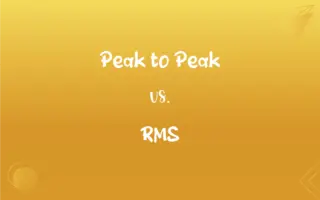Timber vs. Lumber: What's the Difference?
Edited by Aimie Carlson || By Harlon Moss || Updated on October 18, 2023
Timber refers to trees suitable for building or wood from those trees, while lumber is processed wood ready for use in construction.

Key Differences
Timber is often synonymous with trees themselves, especially those that are suitable for processing into wood for building. Lumber, on the other hand, refers to the wood after it has been processed and cut into beams, planks, or other structural formats.
Timber represents the raw or slightly processed material. It can mean trees that are marked for cutting or logs that are freshly cut. Lumber indicates that the wood has undergone a significant processing step, often being sawed and shaped for particular building needs.
Timber, in some contexts, can refer to large squared-off logs or beams used in certain types of structures. Lumber typically pertains to cut and prepared wood pieces like boards or planks, ready for assembly in building projects.
When discussing forestry, timber references the natural resource, emphasizing the importance of sustainable harvesting. Lumber touches on the industrial side, hinting at the processing, marketing, and consumption of the wood resource.
In certain regions, the words timber and lumber might be used interchangeably. However, in the U.S., the distinction remains as mentioned above, with timber often referring to the raw material and lumber to the processed product.
ADVERTISEMENT
Comparison Chart
Definition
Trees suitable for building.
Processed wood ready for construction.
Processing Stage
Raw or slightly processed material.
Fully processed and often cut into shapes.
Usage
Can be used to mean large logs/beams.
Typically refers to boards or planks.
Context
Forestry and raw resource.
Industrial, marketing, and consumption.
Regional Variation
Sometimes used interchangeably.
Clear distinction in the U.S.
ADVERTISEMENT
Timber and Lumber Definitions
Timber
Large squared logs or beams.
The cabin was built using hefty timber beams.
Lumber
Timber converted for use.
The workshop had stacks of lumber ready for crafting furniture.
Timber
Wood that is processed for use in building.
The contractor ordered more timber for the construction site.
Lumber
A source of profit or the means of making a living.
His vast lumber assets ensured his family's financial stability.
Timber
Trees grown for construction purposes.
The forest was filled with prime timber suitable for building.
Lumber
Processed wood cut into planks or beams.
The lumberyard had a sale on premium oak lumber.
Timber
The quality of wood regarding its suitability for building.
The timber from that region is known for its strength and durability.
Lumber
To move clumsily or heavily.
The bear lumbered through the forest searching for food.
Timber
An exclamation used to warn that a tree is about to fall.
As the tree began to tilt, he shouted, Timber!
Lumber
Waste or discarded material.
The old furniture was considered as lumber and thrown out.
Timber
Trees or wooded land considered as a source of wood.
Lumber
Timber sawed into boards, planks, or other structural members of standard or specified length.
Timber
Wood used as a building material; lumber.
Lumber
Something useless or cumbersome.
FAQs
Is all timber suitable for producing lumber?
No, only certain types of timber, often from specific tree species, are suitable for quality lumber.
How is the quality of lumber determined?
It's determined by the type and quality of the timber, the processing method, and other factors like grain and moisture content.
What is timber used for?
Timber is used for building and construction, often after processing.
How is lumber produced?
Lumber is produced by processing timber into beams, planks, and other shapes.
Are timber prices and lumber prices directly connected?
Generally, yes. If timber prices rise, lumber prices often follow due to increased raw material costs.
Can timber and lumber be used interchangeably?
In some regions, yes, but in the U.S., timber typically refers to raw wood or trees, while lumber is the processed product.
Why might lumber warp?
Lumber can warp due to uneven drying, changes in humidity, or internal stresses.
How is lumber graded?
Lumber is graded based on its appearance, strength, defects, and intended use.
What's the difference between hardwood and softwood timber?
Hardwood timber comes from deciduous trees, while softwood timber comes from coniferous trees.
Can lumber be recycled?
Yes, lumber can be recycled or repurposed for various uses.
How long does lumber last?
Depending on its treatment and use, lumber can last many decades, especially if protected from moisture and pests.
What is timberland?
Timberland refers to a large area of land primarily used for growing timber.
How do I store lumber effectively?
Store lumber flat, off the ground, in a dry place, and avoid exposure to extreme temperature changes.
Can timber be used for furniture?
Yes, many pieces of furniture are made from timber, especially after it's processed into lumber.
Are timber and lumber affected by pests?
Yes, both can be affected by pests like termites, but treatments can protect against these threats.
Why is sustainable timber important?
Sustainable timber ensures that forests can regenerate, preserving ecosystems and preventing deforestation.
How can I ensure the lumber I buy is sustainably sourced?
Look for certification labels, like the Forest Stewardship Council (FSC) label, which indicates sustainable practices.
Is timber a renewable resource?
Yes, timber is renewable if forests are managed sustainably and allowed to regenerate.
What are some popular timber tree species?
Popular species include oak, pine, cedar, and maple.
Why is timber seasoning important?
Seasoning, or drying, timber reduces its moisture content, making it stronger and preventing decay.
About Author
Written by
Harlon MossHarlon is a seasoned quality moderator and accomplished content writer for Difference Wiki. An alumnus of the prestigious University of California, he earned his degree in Computer Science. Leveraging his academic background, Harlon brings a meticulous and informed perspective to his work, ensuring content accuracy and excellence.
Edited by
Aimie CarlsonAimie Carlson, holding a master's degree in English literature, is a fervent English language enthusiast. She lends her writing talents to Difference Wiki, a prominent website that specializes in comparisons, offering readers insightful analyses that both captivate and inform.








































































